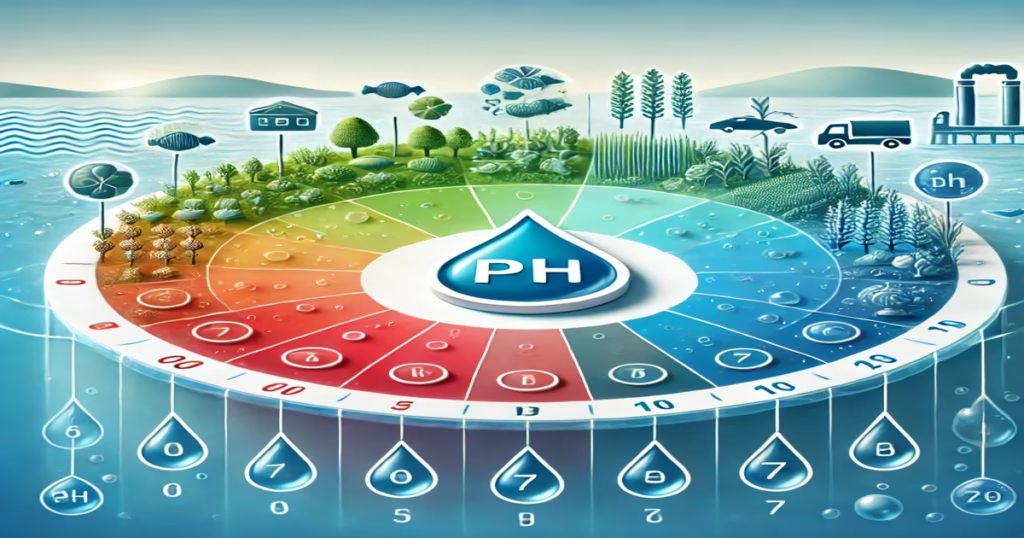Water is an essential component of life, and its quality is influenced by various factors, one of the most significant being pH. Understanding the role of pH in water chemistry is vital for anyone concerned with water treatment, aquatics, or environmental health. This blog post explores what pH is, why it matters, and how it impacts water systems.
What is pH?
pH is a measure of how acidic or basic (alkaline) water is, expressed on a scale ranging from 0 to 14:
- 0 to 6.9: Acidic water
- 7: Neutral water
- 7.1 to 14: Alkaline water
The term pH stands for “potential of hydrogen” and reflects the concentration of hydrogen ions (H⁺) in the water. The pH scale is logarithmic, meaning that each unit change represents a tenfold difference in acidity or alkalinity.
Why is pH Important in Water Chemistry?
The pH of water plays a crucial role in determining its chemical and biological properties. Here’s why pH matters:
- Aquatic Life: Most aquatic organisms thrive in a specific pH range, typically between 6.5 and 9. Extreme pH levels can stress or even kill aquatic life.
- Water Treatment: pH affects the efficiency of water treatment processes, such as disinfection and coagulation. Maintaining the correct pH is essential to prevent corrosion in pipes and optimize chemical reactions.
- Chemical Solubility: pH influences the solubility of minerals and metals. For example, in low pH (acidic) conditions, metals like lead and copper become more soluble, posing a risk to human health.
- Agriculture: The pH of irrigation water affects soil health and plant growth. Water with an inappropriate pH can alter soil chemistry and nutrient availability.
Factors That Affect Water pH
Several factors can influence the pH of water, including:
- Natural Sources: Rainwater is naturally acidic due to dissolved carbon dioxide (CO₂), forming carbonic acid.
- Geology: The types of rocks and soil in an area affect water pH. Limestone, for instance, can increase alkalinity.
- Human Activities: Pollution from industrial discharge, agricultural runoff, and acid rain can alter water pH.
- Biological Processes: Decaying organic matter and the activity of microorganisms can produce acids, lowering pH.
How to Measure pH
pH can be measured using various tools:
- pH Strips: Simple and affordable, but less precise.
- Digital pH Meters: Provide accurate readings and are widely used in laboratories and fieldwork.
- Chemical Test Kits: Use color changes to indicate pH, which is suitable for quick assessments.
pH and Water Systems
1. Drinking Water
The recommended pH range for drinking water is 6.5 to 8.5. Outside this range, water can corrode pipes, leach metals, and have an unpleasant taste.
2. Aquariums
For aquarium enthusiasts, maintaining the right pH is critical for the health of fish and aquatic plants. Different species require specific pH levels, and sudden changes can be harmful.
3. Pools and Spas
In swimming pools, pH should be maintained between 7.2 and 7.8 to ensure effective disinfection and prevent skin irritation.
4. Agriculture
For crops, irrigation water with a balanced pH is essential for nutrient uptake and soil structure.
How to Adjust pH in Water
Adjusting pH involves either neutralizing acidic or alkaline conditions:
- To Increase pH: Add alkaline substances like lime or baking soda.
- To Decrease pH: Use acids such as muriatic acid or citric acid.
Always test water before making adjustments and proceed with care to avoid over-correction.
Conclusion
pH is a fundamental aspect of water chemistry that influences its quality and usability across various applications. By monitoring and managing pH, we can ensure the health of ecosystems, the safety of drinking water, and the effectiveness of industrial processes. Whether you’re maintaining an aquarium, managing agricultural water, or treating drinking water, understanding pH is key to achieving your goals.



